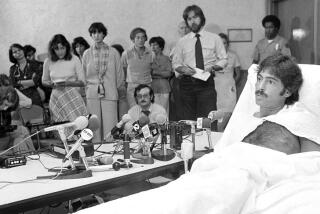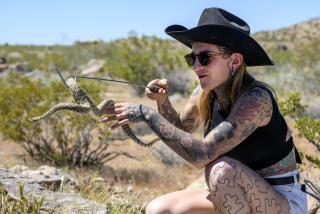Snakes and religion intertwine in the Appalachian thriller ‘Them That Follow’
“Them That Follow,” the Appalachia-set drama about a snake-handling Pentecostal church, features several skin-crawling scenes of rattlesnakes slithering across congregants’ torsos in a bid to prove God’s favor.
To get bitten means to be cast out by both God and the community. Of course, eventually someone gets bitten. But that doesn’t mean the actors were in danger.
“You never actually see the bite and if you do, it’s a fake snake or it’s CGI or something like that,” said Jules Sylvester, a snake wrangler and herpetologist with more than 330 films under his belt. “Or it’s a strike on a fake arm. And by the time you put it together it looks really graphic. It’s movie magic at its finest.”
In the compelling albeit melodramatic movie “Them That Follow,” the daughter of a Pentecostal pastor challenges the traditions of her sect.
The film, now playing in limited release and starring Alice Englert, Walton Goggins, Olivia Colman, Thomas Mann and Kaitlyn Dever, revolves around a secluded Appalachian community, an unusual religious sect and an extreme act of faith. Directors Dan Madison Savage and Britt Poulton, though not members of such a church themselves, say the story hits close to home.
“As a queer person, I think I’m really drawn to stories about misunderstood people,” said Savage. “And I really can’t think of anyone that’s more misunderstood than Pentecostal snake handlers.”
“What initially lit the fire in my belly and pushed me forward in exploring this story was really my own relationship to religion,” said Poulton, who grew up in a Mormon community. “Growing up in a religious home and community wasn’t easy for me. Every choice I made, every need I tried to satiate, I had to not only consider repercussions for myself but for my soul. And that’s a lot of pressure to put on a young person and certainly something I really struggled under.”
Similarly, the film follows along as the pastor’s daughter (Englert) is forced to choose between her faith and her heart after falling in love with a man (Mann) who has turned his back on the church.
“I was interested in exploring through our film this journey of a young woman who grows up despite these constraints,” said Poulton. “Who has to reconcile faith and doubt, knowledge, instincts, this life and the next, all to come of age. That’s what I really connected to.”
The directors, who also wrote the script, had to do considerable research to get the story right. “We watched all the documentaries, read all of the books and then we sort of let it go because at the end of the day, this is a fictional film,” said Savage. “It’s a fictionalized account of one church inspired by the very real practices that still occur today throughout the southern United States.”
Shooting took place in Ohio, where the directors managed to sit in on a Pentecostal church service, albeit a snake-less one.
“Even though they weren’t snake-handling churches, it’s important to know that snake-handling is just an escalation of Pentecostalism,” said Poulton. “What Pentecostal churches and snake-handling churches have in common are so many things from speaking in tongues to faith healing. And it’s really, really powerful to be able to witness people live their relationship with the divine out loud.”
While Christian mythology has long cast snakes as being a symbol the devil, Pentecostal snake-wrangling churches take their cue from the book of Mark, in which the faithful are said to be safe in the face of dangerous serpents.
“The father of snake-handling, George Hensley, he interpreted the word ‘serpent’ to mean poisonous snake,” said Poulton. “And for him, that meant a true test of the faithful was to confront a deadly being, hold it in your hands without fear and with absolute faith and know that you would come out on the other side. So their perspective is very literal.”
“Picking up that snake is submitting yourself to the divine will, for better or for worse,” added Savage.
Though the bites were fake, the snakes were most definitely real. Altogether, Sylvester says he brought about 14 snakes with him for the film including rattlers, pythons, rat snakes and carpet snakes. “And another one that no one really knows what kind of snake it is, but it looks scary,” he said. “They all looked really scary.”
While the actors may not have been in any imminent danger, they did have to get pretty cozy with the reptiles during filming.
“There’s always a little bit of trepidation when you’re dealing with snakes,” Sylvester said. “But they’ve been hand raised by me and I’ve had them for years so they’re quite [amenable] to being handled. After about 10 minutes all of a sudden [the actors] are really comfortable with the snakes and by the end of the shoot they’re quite enamored of the snakes completely.”
Goggins, who plays pastor Lemuel Childs in the film, had to work most intimately with the snakes and by extension, Sylvester. “I showed him how to pick up the snake and how to hold it properly without gripping it and let him know that the snake is not out to hurt him,” Sylvester said. “I told him, ‘You’re a tree, you’re a tree, you’re a tree. Just act like the branch of a tree.’”
The 68-year-old got his start as a herpetologist in 1966 wrangling snakes for the Nairobi National Museum at the tender age of 16. Incidentally, it was also his first brush with the serpents after he encountered one during a run.
“I lived right next door to the Nairobi snake park,” he recalled. “And there was like a 14-foot python on the bed of the Nairobi river all curled up. I said, ‘Hey, there’s a big snake down there!’ And this guy comes on a motorcycle, slid down the bank and lept up on this python. And I thought that was the most incredible job, and he actually got paid for doing that! I really wanted that job very, very badly so I volunteered and they actually gave me a job.”
After holding the position for the next few years, Sylvester said he quickly realized he knew more about snakes than anyone else in Nairobi. “[Since then] I’ve spent half my life just wandering around the bush looking for snakes.”
“He has the most interesting life, the most interesting stories,” Poulton said of Sylvester. “What was most important for Dan and I as animal lovers was working with somebody that we trusted to make the first and last priority the animals and their health and safety. And after meeting with Jules, we felt like we were in the very best of hands. He is extremely knowledgeable, has a lifetime of experience and we knew that our animals would be safe with him.”
Sylvester has wrangled everything from snakes and spiders to cockroaches to flies on films including “Jurassic Park,” “Godzilla,” “Indiana Jones and the Kingdom of the Crystal Skull,” “Casino Royale” and “Hook.” Among his favorite experiences were the Frank Marshall films “Congo” and “Arachnophobia,” and more recently, 2006’s “Snakes on a Plane” starring Samuel L. Jackson.
“We had so much fun on that set,” said Sylvester. “Samuel Jackson is just brilliant. His agent was pretty nervous about him getting bitten by a snake. But he was actually quite comfortable with the snakes, he was very good with them. I had probably 350 snakes [on that set], it was just wonderful.”
For this project, Sylvester was the first person attached, even before any of the actors. “I emailed Jules on a whim and thus began our many years-long correspondence about both the creative and practical and safety aspects of working with these animals,” Savage said. “And he was a wonderful asset to have on set both personally, professionally and even creatively helping us bring our vision of Pentecostal snake-handling to life.”
“But even Jules with all of his wisdom and charm couldn’t prepare us for being confronted with real, live rattlesnakes,” said Poulton. “Of course the actors never handled dangerous or venomous snakes but we did shoot with real rattlesnakes. And I have to tell you — I’m not scared of snakes, and in fact I love reptiles — but to hear a rattlesnake’s rattle, it’s a visceral, primal reaction. Your body goes into fight or flight, and it’s like nothing I’ve ever experienced.
“Even though I knew there was a piece of glass between me and certain death, I really truly lost my breath and for the first time really understood what snake handlers must go through each and every Sunday.”
More to Read
Only good movies
Get the Indie Focus newsletter, Mark Olsen's weekly guide to the world of cinema.
You may occasionally receive promotional content from the Los Angeles Times.











